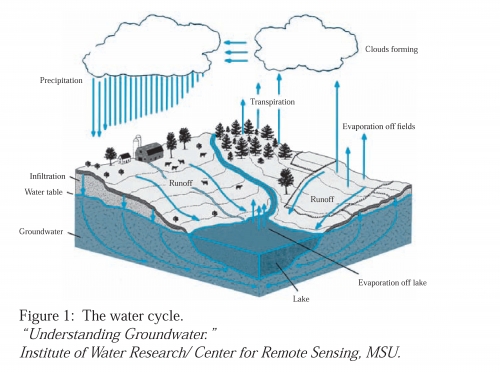Understanding the water cycle is key to protecting Michigan’s vast water resources
Groundwater, Surface Water. . . It’s All Connected!

Water is essential to all living things and has been continuously reused and recycled over and over for thousands of years. Because it is a non-renewable resource, it’s not possible to produce new water. All the water on earth today is the same amount that existed years ago, and is the amount of water we will have in the future.
Importantly, a vast majority of the water on earth is not suitable for use by plants, animals, and humans— nearly all of it (about 97 percent) is salt water. Freshwater makes up only about 3 percent of the earth’s water. Of this freshwater, two-thirds is frozen polar ice caps and glaciers and is not accessible, leaving very little freshwater available for use.
As both demand and competition for this limited resource continue to grow, a basic understand of how water cycles through a variety of phases will allow us to properly protect our water resources.
The water or hydrologic cycle (Figure 1) describes the constant movement or cycling of water on, above, and below the surface of the earth. Water moves from land to groundwater to surface water to air. Precipitation—rain, snow, sleet and hail—brings water to the earth. This is taken up by the ground through infiltration.Groundwater is the water that fills the spaces between rock and soil particles.
Plants may take up the moisture and release it back into the air through the process of transpiration. Some of the precipitation runs off the surface of the ground and into surface waters such as lakes and streams. These bodies of water may lose water to groundwater if the water table is low or gain water from the groundwater if the water table is high. These bodies may also lose moisture through evaporation, which occurs even in cold weather if the water is not ice-covered.
In Michigan, the water moves to the Great Lakes and then on to the Atlantic Ocean.
As you can see, the water cycle illustrates how groundwater and surface water area interconnected.
Simply, it is not possible to separate the two water sources because they feed into each other. At any point, our actions at the local level can have multiple impacts on water as it moves through the water cycle. Identifying practices that may pose risks to Michigan’s water resources will allow individuals to help protect Michigan’s surface and groundwater resources and ensure their availability in the future.
Remember, everyone lives in a watershed, the area of land that drains to a common body of water. What happens on your property can affect the entire watershed and beyond! The next time you use fertilizers or pesticides, consider how this may impact the lake you live on or the water you drink.
The Home*A*Syst Guide (WQ-51) can help assess your potential for environmental risks in and around your home. It is available through the MSU Extension Bookstore.



 Print
Print Email
Email




